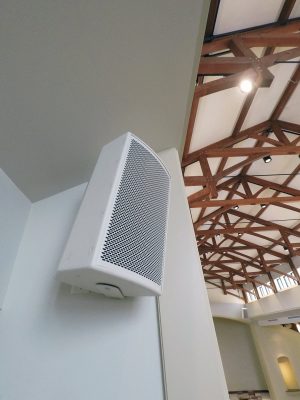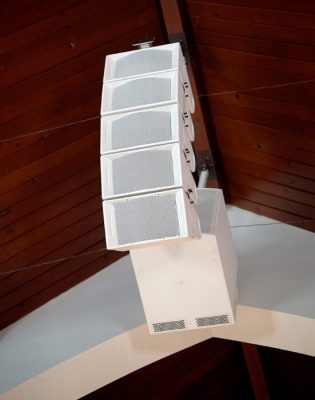What Speaker System is Best for Your Space?
When looking to purchase a new sound system for your sanctuary, there are a number of factors to consider. How to choose the correct loudspeaker type from all of the different options on the market? Knowing that each type of loudspeaker was conceived with a specific application in mind may help weed out products that are not a good fit for your project. While there are many factors to sift through, some of the primary considerations include:
- Size and shape of the sanctuary and seating area. This will be one of the primary factors determining the location and quantity of loudspeakers required to provide smooth coverage of the seating areas.
- Ancillary areas/spaces that require coverage
- Acoustically reflective surfaces and room reverberation. “Live” rooms require more control of sound dispersion to maintain clarity and speech intelligibility.
- Sightlines and aesthetics. Loudspeakers must be located to provide the necessary audio performance while minimizing visual intrusion.
- Performance goals. The style of worship and type of music the system will need to support is an important consideration.
As an overview, loudspeaker types can be grouped into a few general categories:
Point Source Loudspeakers

Fulcrum Acoustic DX1577 Dual 15 inch Coaxial Loudspeakers and DX896 Dual 8 inch Coaxial Loudspeaker at Saint Pius X Church, Rochester, NY
For years, these were the most common loudspeaker types used in worship spaces. Point source loudspeakers (sometimes also referred to as “point and shoot”) are intended to be used individually, or possibly in small groups (or “arrays”) depending on their design. This type of speaker typically incorporates a horn (or multiple horns). The horns define a specific vertical and horizontal coverage angle. Generally speaking, smaller horns can only control the dispersion of high frequency sounds. Larger horns are required to control middle and lower frequencies. Broad-band dispersion control is particularly important in larger, more reverberant spaces. Point source speakers are available in a variety of sizes, dispersion characteristics and output ranges. Systems can be found that will fit many budgets performance criteria.
Column Array Speakers
Column Array Speakers are also a popular choice for house of worship sound. Column speakers are comprised of multiple small cone-type drivers vertically-arrayed within a tall but narrow enclosure, resulting in tight (narrow) vertical dispersion and wide horizontal dispersion. Some designs supplement the cone drivers with dedicated tweeter elements. The resulting dispersion characteristics can make them a good choice for facilities with hard, reflective surfaces or larger, reverberant spaces. The physically narrow design of the speaker enclosure allows them to work well in gothic forms of architecture since they can be mounted to and blend in with building columns. The layout/placement of column loudspeakers within a space is critical to the success of the system, particularly in reverberant spaces.
Line Arrays
A line array is a vertically-stacked group of individual full-range speaker modules, typically suspended in a J-shaped array. Note that the individual modules within a Line Array are specifically designed for this purpose and possess unique acoustical attributes that allow them to work together in this type of array. Due to their large size, line arrays are typically hung from the ceiling in the vicinity of the stage/altar. While a popular solution for high-output music applications and large format concerts, line arrays are not suitable for every space. They tend to excel in rooms that are deep and not too wide and require suitable ceiling height due to their vertical size.
The exact shape of the array and number of individual modules required is based on the specifics of the deployment. The curve of the array helps to tailor the coverage based on the throw distances, location of nearest seats, etc. In wide rooms, multiple arrays may be required to achieve satisfactory horizontal coverage. Due to the number of modules required along with the supporting number of amplifier channels, Line Arrays tend to be a more expensive solution than other approaches. However, there are certain room types that can benefit from the broadband vertical dispersion control that a properly sized line array can offer.

Fulcrum Acoustic FL283 Dual 8 inch Subcardioid Line Array Modules and CS121 21 inch Subcardioid Subwoofer at Anaheim Christian Reformed Church, Anaheim, CA
Subwoofers
Any of the above loudspeaker types can be supplemented by subwoofers. Subwoofers will extend the low-frequency capability of a system. Whether or not subwoofers will be required depends upon:
- Program type: Amplified music requires more low frequency support than speech.
- Low frequency capability of the mains speakers: Certain mains loudspeakers may provide sufficient low frequency output to meet low frequency needs without supplementary subwoofers.
- Output goals: Lightly amplified music may be able to be accommodated by the mains speakers alone; highly amplified music would certainly require subwoofers.
Subwoofers are available in a wide variety of formats/sizes. Subwoofer selection should be mindful of the above criteria and consideration of the exact capabilities and type of the mains loudspeakers.
Portable vs. Installed Loudspeakers
Another factor to consider is whether the speakers are to be permanently installed or need to travel between facilities. Portable speakers include features that allow them to be set up and transported easily. Some of these features include:
- Handles to facilitate physical movement of the speaker
- Pole mounts to allow smaller speakers to be set atop speaker tripods.
- Caster pallets – wheeled dollies make it easier to move heavier speakers
- “Flying” systems – purpose-designed structural systems that allow loudspeakers to be easily and safely suspended from a temporary truss, etc.
Loudspeakers intended for installation forgo these options (some of which can be quite costly) but include built in suspension points intended for hanging the speakers. Always use the manufacturers’-provided suspension points when installing loudspeakers as such points have been engineered for this purpose. Never modify a loudspeaker enclosure by adding screw eyes, bolts, etc. to hang the speaker, and never suspend a loudspeaker by using ropes, chains, etc. looped around handles.
Portable loudspeakers can be Point Source, Column-Type or Line Arrays.
Loudspeakers with Integrated Electronics
Many different types of loudspeakers are available with electronics (amplifiers, equalizers, digital signal processors) built in to the loudspeaker enclosure. This can simplify system setup for portable systems since additional rack-mount equipment and the associated wiring can be avoided. For installations, so-called “self-powered” loudspeakers may not be suitable or cost effective. Self-powered loudspeakers require separate cabling for signal and power; this adds wiring cost and complexity. Additionally, many installations can realize economies by connecting multiple passive loudspeakers to a single rack-mounted amplifier. Self-powered speakers require separate amplifiers for each loudspeaker, thereby (potentially) increasing the number of amplifiers that might otherwise be required. Existing facilities that do not have space for equipment racks could be good candidates for installed self-powered systems, but this may come with a cost premium.
Electronically Steered Systems
Certain systems allow their coverage to be tailored electronically. This type of system requires multiple drivers, multiple amplifier channels and multiple digital signal processor (DSP) channels. The form of the system could be a Line Array or Column speaker. While electronic “steering” adds cost and complexity, it can be useful when suitable mounting locations and/or difficult room acoustics present themselves. Assessing the suitability of a steered system and configuring such systems in the field require substantial experience and expertise.
While there are pros and cons to each system, understanding your facility and your audio needs will help narrow down your search. As always, an integrator/installer/designer familiar with house of worship audio should be the first call you make. An experienced professional can help establish goals, set budgets, select primary and ancillary equipment, organize installation details and coordinate the work of other trades (electrical contractors, rigging contractors, etc.).

